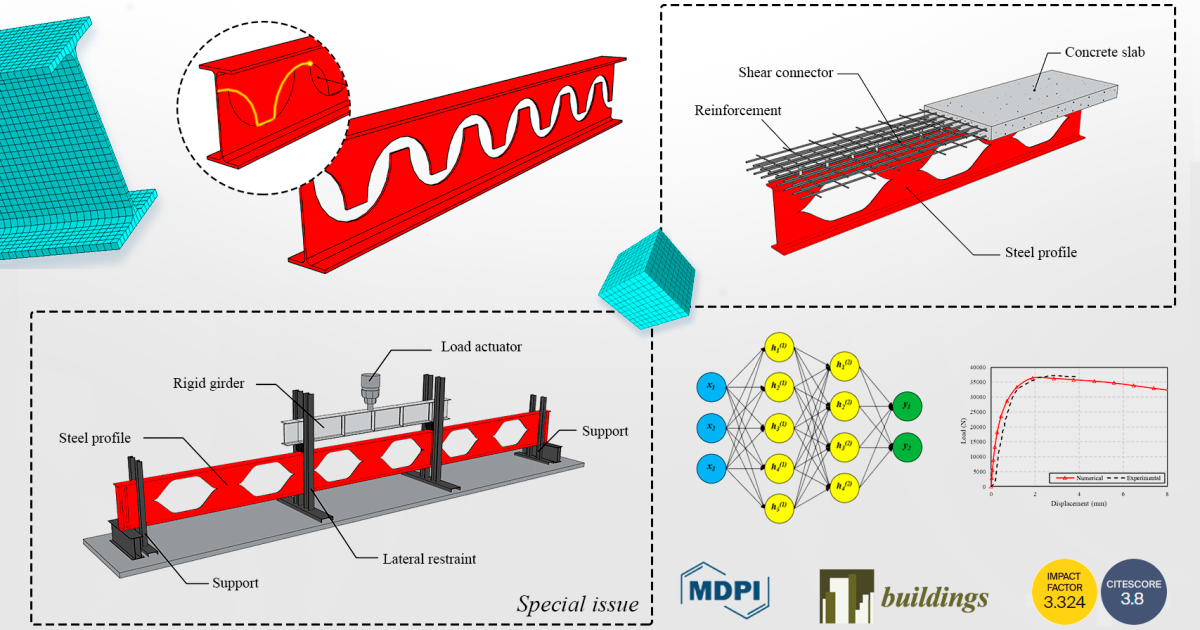Mechanical Performance of Steel and Composite Beams
A special issue of Buildings (ISSN 2075-5309). This special issue belongs to the section "Building Structures".
Deadline for manuscript submissions: 31 May 2024 | Viewed by 8694

Special Issue Editors
Interests: steel structures; beams with openings; buckling; and post-buckling analysis; fire resistance; composite structures
Interests: steel structures; beams with openings; buckling; and post-buckling analysis; fire resistance; composite structures
Interests: composite materials; sustainability; concrete structures; steel structures; FRP; pultruded materials
Special Issues, Collections and Topics in MDPI journals
Special Issue Information
Dear Colleagues,
We invite you to contribute original research to a Special Issue on the "Mechanical Performance of Steel and Composite Beams".
Steel is mainly used for structural purposes due to its rigidity, durability, flexibility in architecture, and high strength-to-weight ratio. Research and innovation in steel technology may soon take construction in entirely new directions. Stainless steel is a high-performance construction material that is synonymous with modern, resilient, and sustainable construction. In this way, the use of stainless steel in the case of bridges and other large modern structures is already a reality. Stainless steel is suitable when considering design life and lifecycle cost, future maintenance requirements, sustainability, and aesthetic demands.
Openings in beams can be made when necessary to install service ducts. This type of beam is more susceptible to instability problems and localized plasticization. For steel beams, using high-strength steel is an exciting solution. The forthcoming publication of the new Eurocode 3 – Design of steel structures – Part 1–13: Rules for beams with large web openings will undoubtedly boost research and publications in this area.
The use of composite structures is increasing in the construction industry due to their higher load-bearing capacity, better structural fire performance, and more significant potential to provide optimized structural solutions, effectively creating synergies between structural materials. Regarding composite structures, the new trends are innovative solutions combining different structural materials, such as steel and concrete (conventional and UHPC) as well as steel and CLT (cross-laminated wood), among others, applicable to buildings, bridges, infrastructure, and connectors at the interface of the most efficient materials. Various types of fibers in composite structures also deserve special attention in research. Regarding composite structures, there is still research on functionally graded materials (FGMs).
Additionally, steel and composite structures are prone to fire accidents, which is why fireproof systems are installed in residential and industrial buildings. New technologies and new fireproof materials can increase the longevity and strength of these structures, making them highly resistant to fire.
Finally, we highlight machine learning (ML), which has become the most successful branch of artificial intelligence (AI). It offers a unique opportunity to make structural engineering more predictable due to its ability to deal with complex nonlinear structural systems. There is a significant growth in research and techniques for implementing ML in structural engineering, thanks to recent advances in ML techniques and computational resources, as well as the availability of large datasets.
Thus, this Special Issue aims to gather accounts of research related to the “Mechanical Performance of Steel and Composite Beams".
We encourage you to submit manuscripts containing scientific findings on composite and steel beams based on theoretical and practice-oriented articles, including experimental and/or numerical studies, case studies, and review articles. Papers on one or more of the following subjects are especially welcomed:
- Steel beams;
- Composite beams;
- Steel and reinforced concrete beams with web openings;
- Nonlinear finite-element analysis;
- Buckling or post-buckling analysis;
- Machine learning;
- Fire resistance;
- Stainless steel;
- Fibers;
- Composite materials.
Dr. Carlos Humberto Martins
Dr. Alexandre Rossi
Dr. Yasin Onuralp Özkılıç
Guest Editors
Manuscript Submission Information
Manuscripts should be submitted online at www.mdpi.com by registering and logging in to this website. Once you are registered, click here to go to the submission form. Manuscripts can be submitted until the deadline. All submissions that pass pre-check are peer-reviewed. Accepted papers will be published continuously in the journal (as soon as accepted) and will be listed together on the special issue website. Research articles, review articles as well as short communications are invited. For planned papers, a title and short abstract (about 100 words) can be sent to the Editorial Office for announcement on this website.
Submitted manuscripts should not have been published previously, nor be under consideration for publication elsewhere (except conference proceedings papers). All manuscripts are thoroughly refereed through a single-blind peer-review process. A guide for authors and other relevant information for submission of manuscripts is available on the Instructions for Authors page. Buildings is an international peer-reviewed open access monthly journal published by MDPI.
Please visit the Instructions for Authors page before submitting a manuscript. The Article Processing Charge (APC) for publication in this open access journal is 2600 CHF (Swiss Francs). Submitted papers should be well formatted and use good English. Authors may use MDPI's English editing service prior to publication or during author revisions.
Keywords
- steel beams
- composite beams
- machine learning
- stainless steel
- fire resistance
Planned Papers
The below list represents only planned manuscripts. Some of these manuscripts have not been received by the Editorial Office yet. Papers submitted to MDPI journals are subject to peer-review.
Title: Steel Columns Compression Behavior in Lipped Channel Section with Web Stiffener
Authors: Danielle Mayumi Amano Hirano; Felipe Nascimento Arroyo; André Luis Christoforo; Emerson Alexandro Bolandim; Vinicius Borges de Moura Aquino; Wanderson Fernando Maia
Affiliation: Department of Civil Engineering, São Paulo State University (UNESP), Ilha Solteira 15385-000, Sao Paulo, Brazil
Abstract: Steel in civil construction has become more frequent. Among the existing variations, cold-formed steel columns have been relevant. These columns can receive application of intermediate longitudinal stiffeners aiming to improve their behavior; however, the standards do not provide a specific procedure for their sizing. Therefore, this paper sought to analyze the behavior of cold-formed steel columns of lipped channel section longitudinally stiffened in the web and submitted to compression. In this study, was used non-linear numerical analysis with the aid of the ANSYS software based on the Finite Element Method, varying the columns geometry and length. The results were compared with experimental tests carried out by literature, in addition to an analysis in relation to the American Standard procedure. The results obtained demonstrated a coherence of the numerical model used in relation to the experiment. Also, emphasized that the normative procedure proved to be against safety for most of the analyzed cases, showing the need to adapt the procedure for the design of stiffened U sections with intermediate stiffeners in the web.







